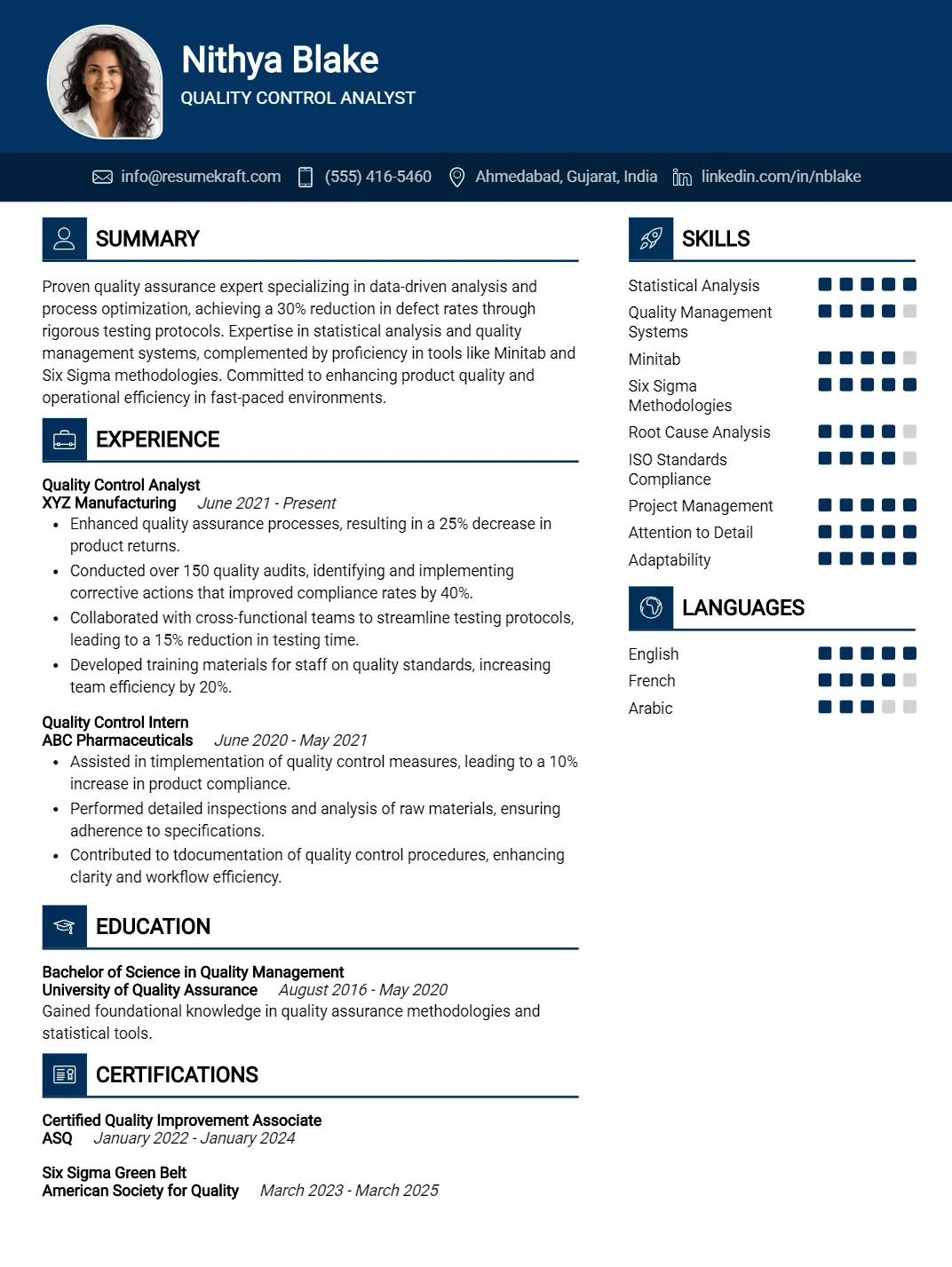
The role of a Quality Assurance (QA) professional is pivotal in ensuring that products meet specified standards and function flawlessly before reaching consumers. QA specialists are responsible for identifying defects, improving processes, and implementing testing methods that guarantee quality and performance. In today’s competitive job market, where consumer expectations are higher than ever, the importance of quality assurance cannot be overstated. This article aims to provide insights into crafting an effective resume tailored for QA positions, highlighting essential skills, achievements, and strategies to stand out in this crucial field.
- Quality Assurance resume examples
- How to format a Quality Assurance resume
- How to write your Quality Assurance resume experience
- How to list your hard skills and soft skills on your resume
- How to list your certifications and education on your resume
- How to write your Quality Assurance resume summary or objective
- Additional sections for a Quality Assurance resume
- Key takeaways for writing a professional Quality Assurance resume
- Frequently Asked Questions
Quality Assurance resume examples
Quality Assurance resume examples serve as a vital resource for job seekers aiming to showcase their skills and experiences effectively. These examples illustrate the essential components of a strong QA resume, helping candidates understand how to highlight relevant technical skills, certifications, and accomplishments. By studying these samples, applicants can better tailor their resumes to meet industry standards and stand out to potential employers in the competitive QA field.
Quality Assurance Resume
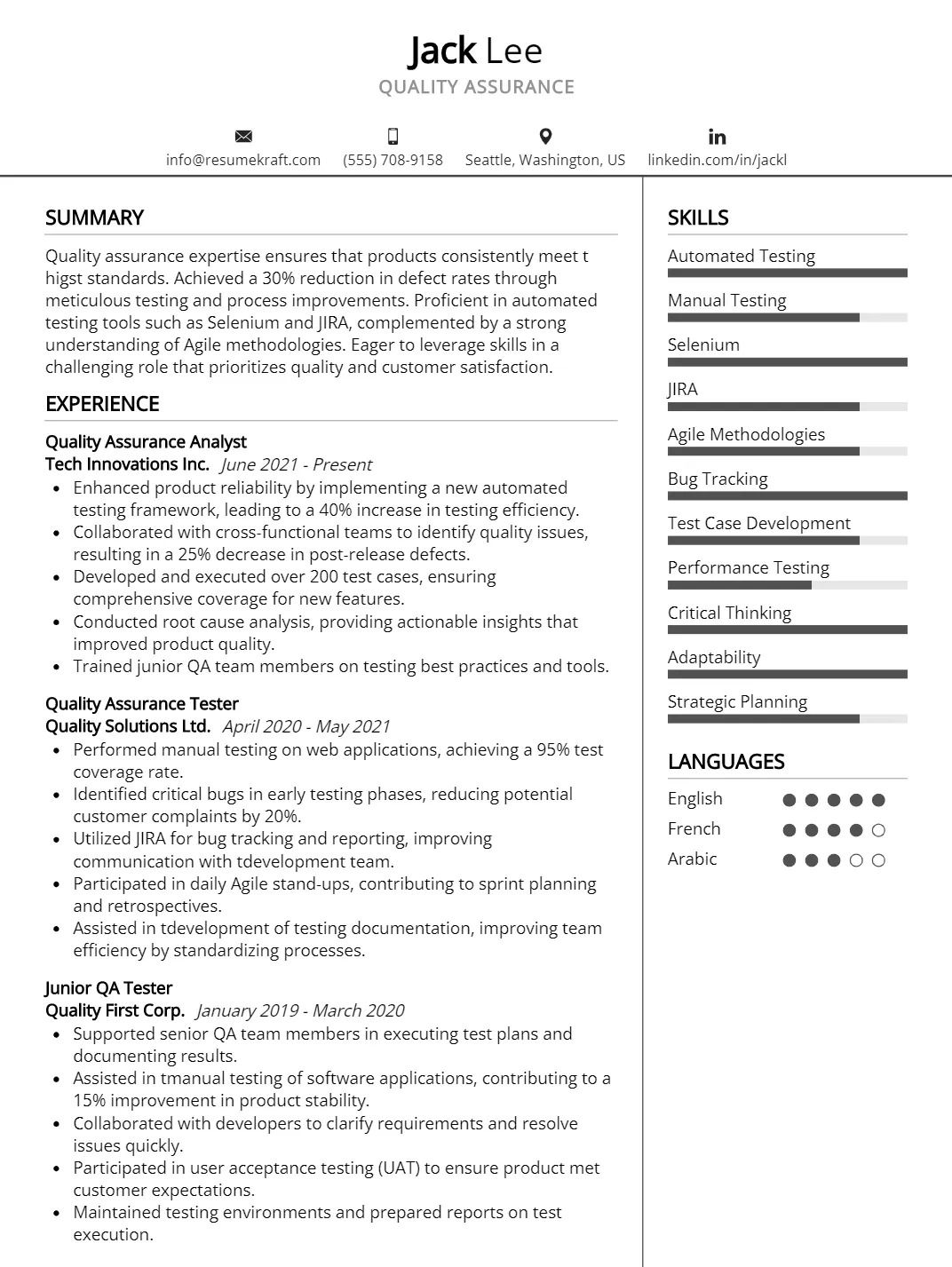
Why This Resume Works
This resume effectively highlights the candidate’s relevant skills and experience for a Quality Assurance position, showcasing expertise in both automated and manual testing using tools like Selenium and JIRA. The clear format emphasizes their six years of progressive QA roles, making it easy for employers to assess qualifications quickly. Additionally, the use of industry-specific keywords enhances ATS compatibility. Strategic presentation of achievements, such as successful project completions within Agile methodologies, further strengthens the application by demonstrating tangible contributions to previous teams.
Quality Control Analyst Resume

Why This Resume Works
This resume effectively highlights the candidate’s relevant skills and experience for the Quality Control Analyst position, showcasing expertise in statistical analysis and Six Sigma methodologies. The structured format emphasizes key competencies, ensuring clarity and easy navigation for hiring managers. Its alignment with ATS compatibility is achieved through targeted keywords such as “Quality Management Systems” and “Root Cause Analysis.” Additionally, the strategic presentation of achievements underscores quantifiable results in quality improvement, making it highly appealing to potential employers in this field.
Quality Assurance Specialist with Software specialization Resume
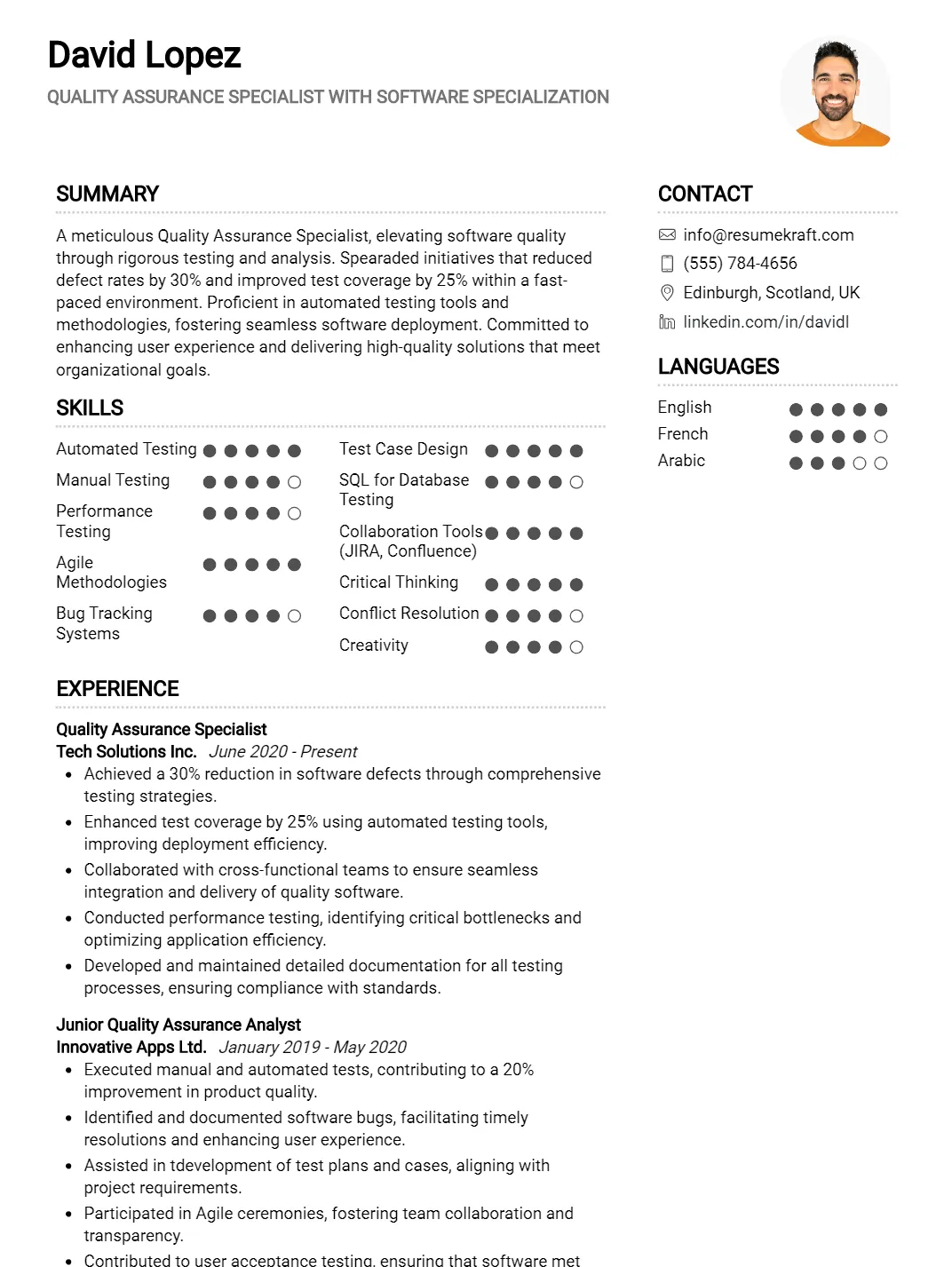
Why This Resume Works
This resume effectively targets the Quality Assurance Specialist with Software specialization position by showcasing essential skills such as Automated Testing and Agile Methodologies, directly aligning with industry demands. Its clear format enhances readability, allowing hiring managers to quickly assess qualifications. The structured presentation addresses ATS compatibility through relevant keywords like Bug Tracking Systems. Additionally, highlighting achievements from six years of experience emphasizes practical expertise in performance testing and problem-solving, making this resume a compelling choice for prospective employers in software quality assurance.
Quality Assurance Transition from software developer Resume
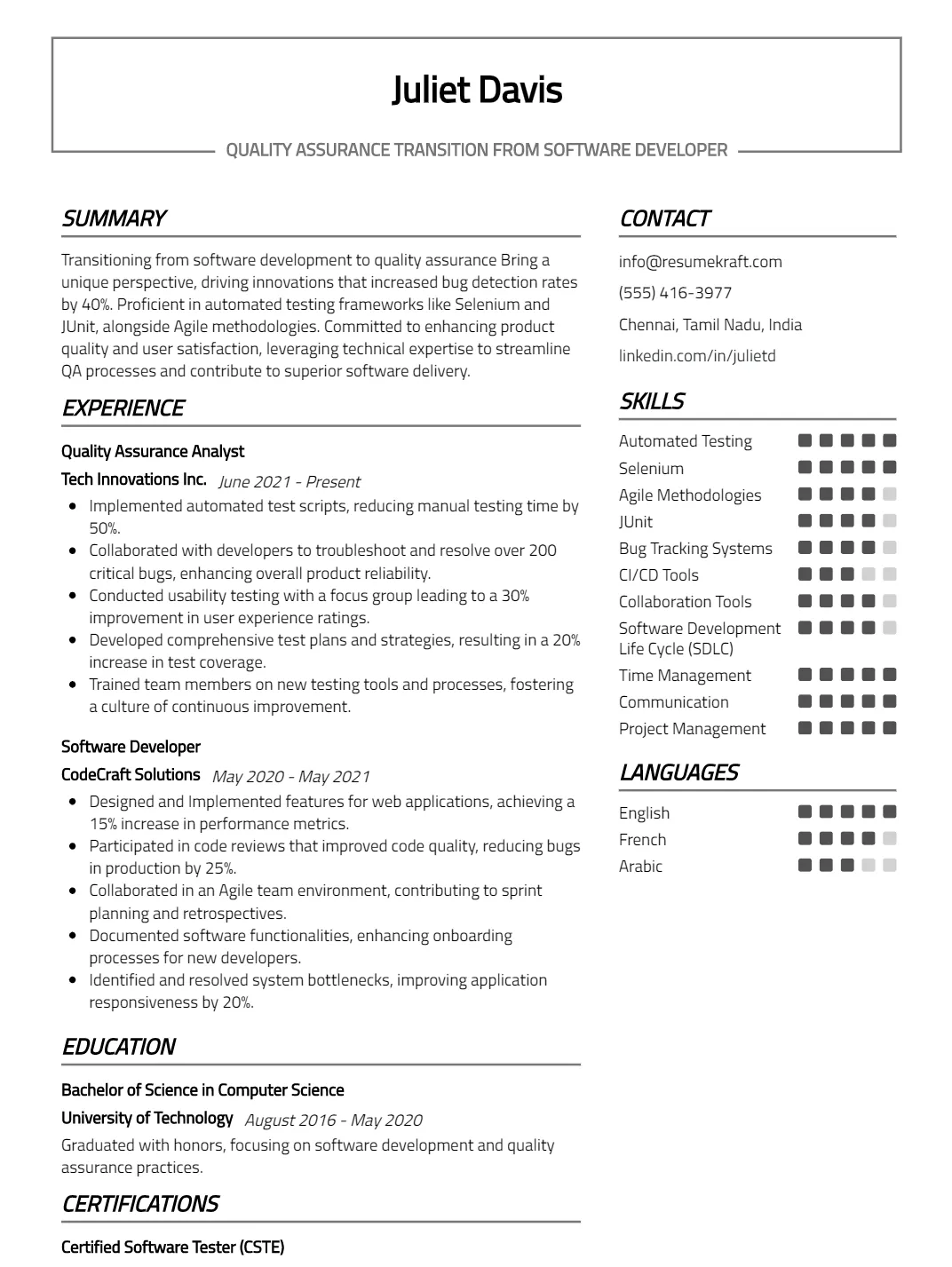
Why This Resume Works
This resume effectively showcases a strong transition from software development to Quality Assurance by highlighting relevant skills such as automated testing, Selenium, and Agile methodologies. The structured format emphasizes key experiences, making it easy for hiring managers to identify qualifications at a glance. Additionally, the use of industry-specific keywords ensures ATS compatibility, increasing visibility in applicant tracking systems. Strategic presentation of achievements related to bug tracking and test automation further demonstrates the candidate’s capability to excel in a QA role, enhancing overall appeal.
International Quality Assurance Consultant Resume
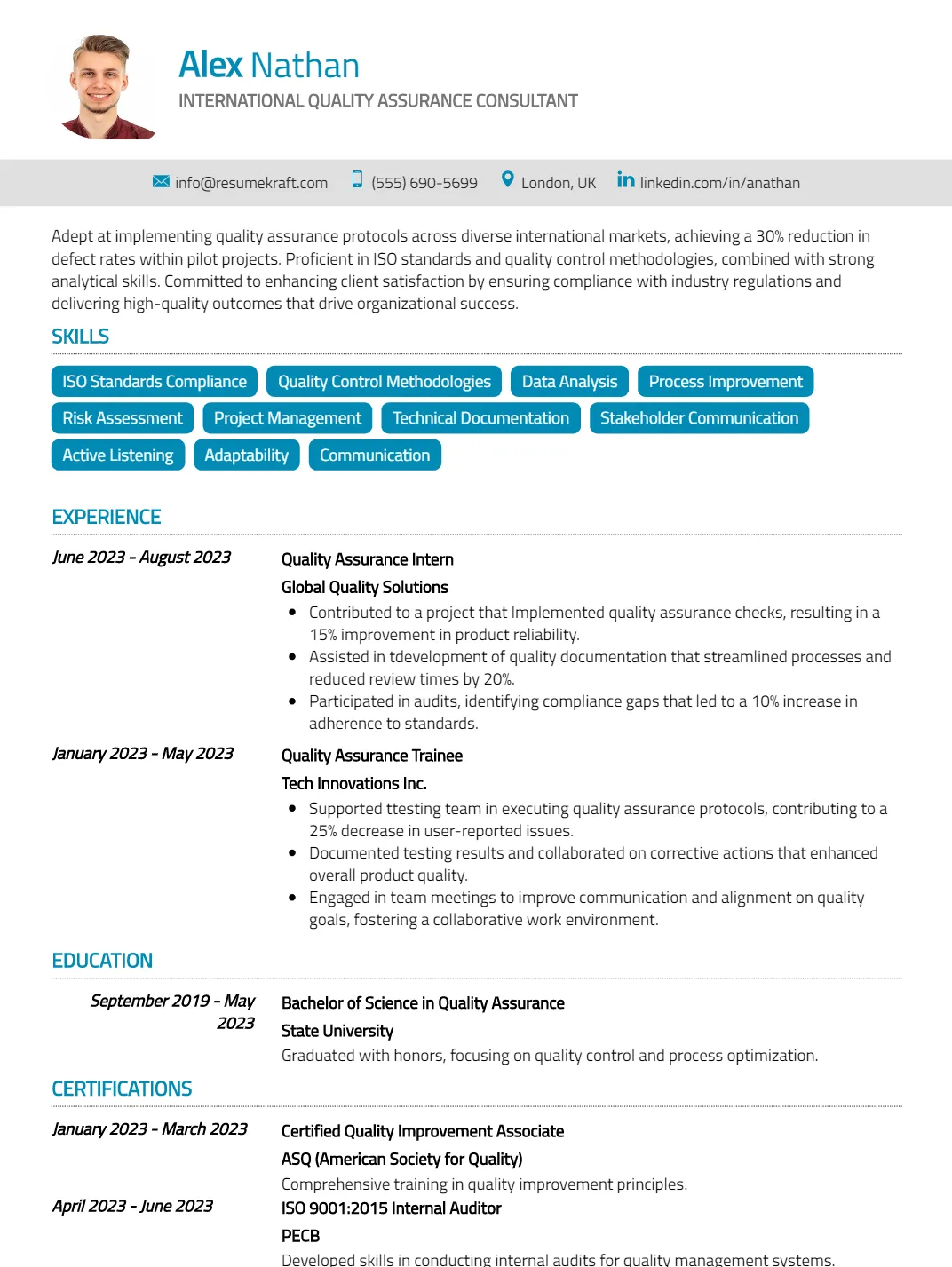
Why This Resume Works
This resume effectively positions the candidate for an International Quality Assurance Consultant role by highlighting key skills such as ISO Standards Compliance and Risk Assessment, which are critical in global quality frameworks. The structured format emphasizes relevant experience through roles like Quality Assurance Intern and Trainee, showcasing a solid foundation in quality control methodologies. Its ATS compatibility is ensured with industry-specific keywords, while strategically presented achievements demonstrate measurable contributions to process improvement, making it compelling for employers seeking expertise in international quality standards.
Quality Assurance with Software Specialization Resume
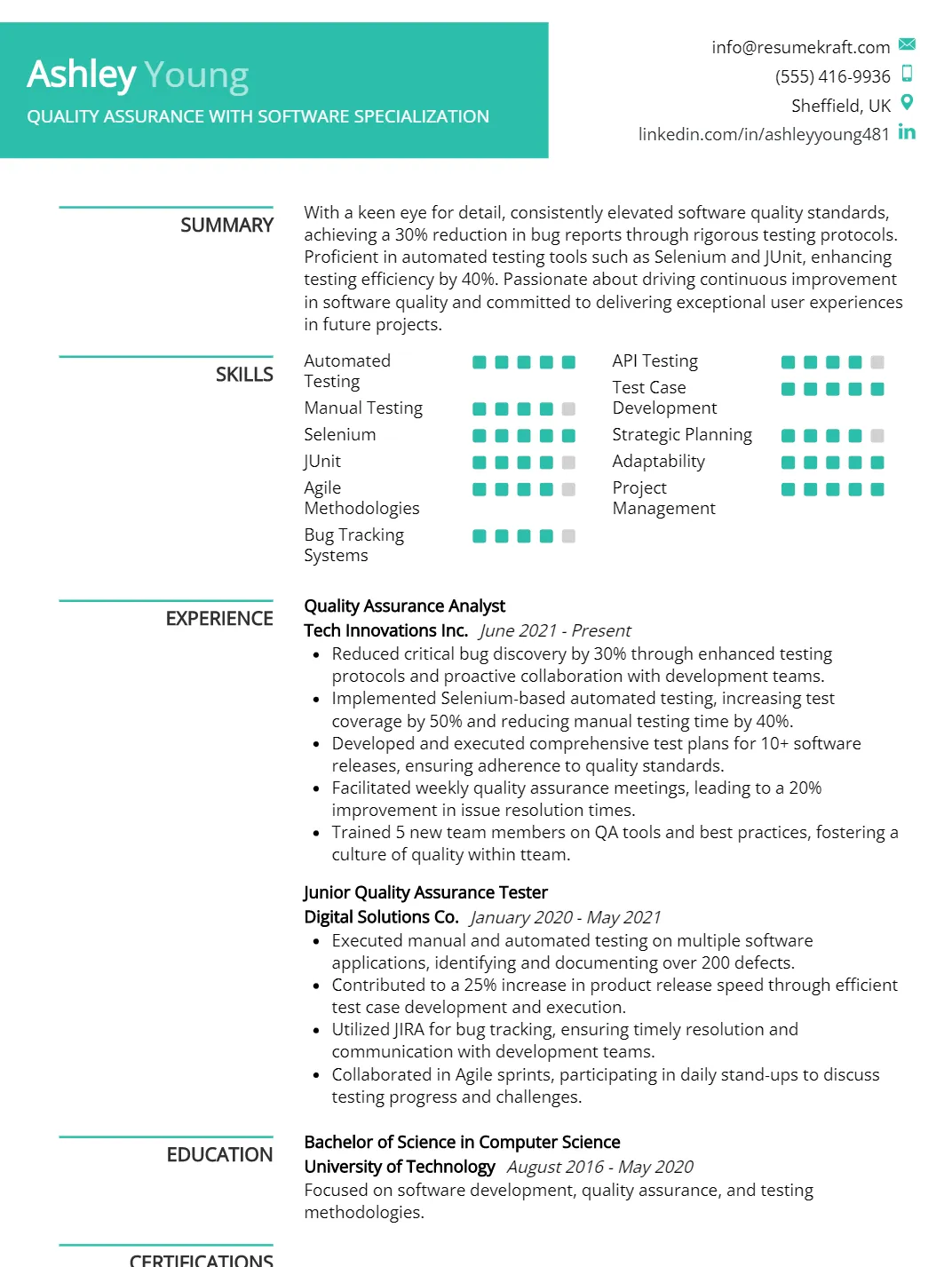
Why This Resume Works
This resume effectively highlights relevant skills such as Automated Testing and Selenium, directly aligning with the Quality Assurance with Software Specialization position. With five years of experience in both analytical and testing roles, it demonstrates a solid foundation in Agile methodologies, essential for modern software development. The clear format enhances readability, making it ATS-compatible by incorporating industry-specific keywords. Additionally, strategic presentation of achievements showcases quantifiable contributions to quality improvement, making this candidate stand out in a competitive job market.
Senior Quality Assurance Engineer – Medical Devices Resume
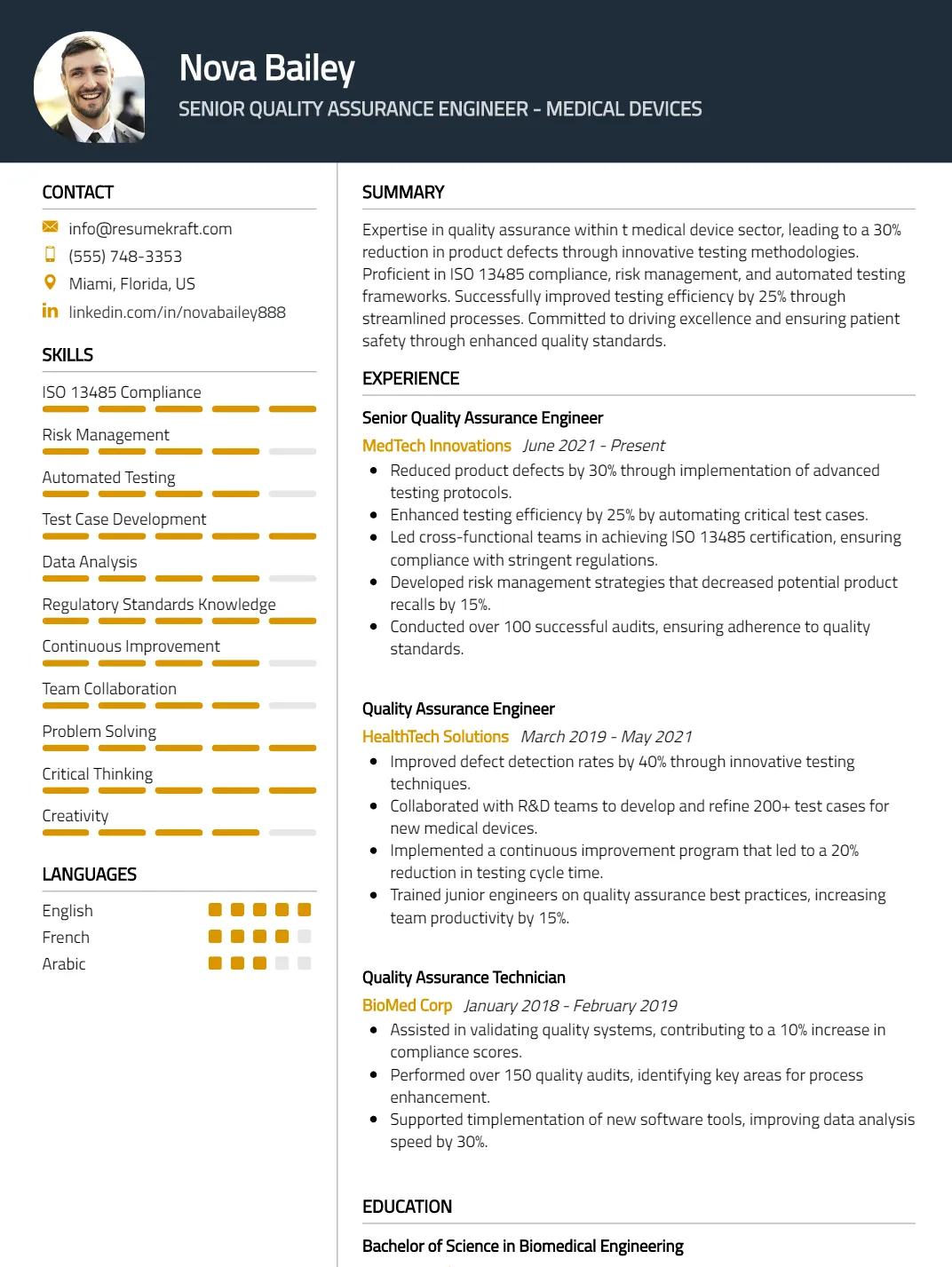
Why This Resume Works
This resume is effective for a Senior Quality Assurance Engineer – Medical Devices position due to its emphasis on key skills like ISO 13485 compliance and risk management critical for regulatory adherence. The structured format highlights progressive experience, showcasing a clear career trajectory over seven years in quality assurance roles. It features industry-specific terminology, enhancing ATS compatibility. Additionally, the strategic presentation of achievements, such as successful automated testing projects and impactful data analysis, directly addresses the expectations of hiring managers in this field.
Lead Quality Assurance Auditor – Food Safety Resume
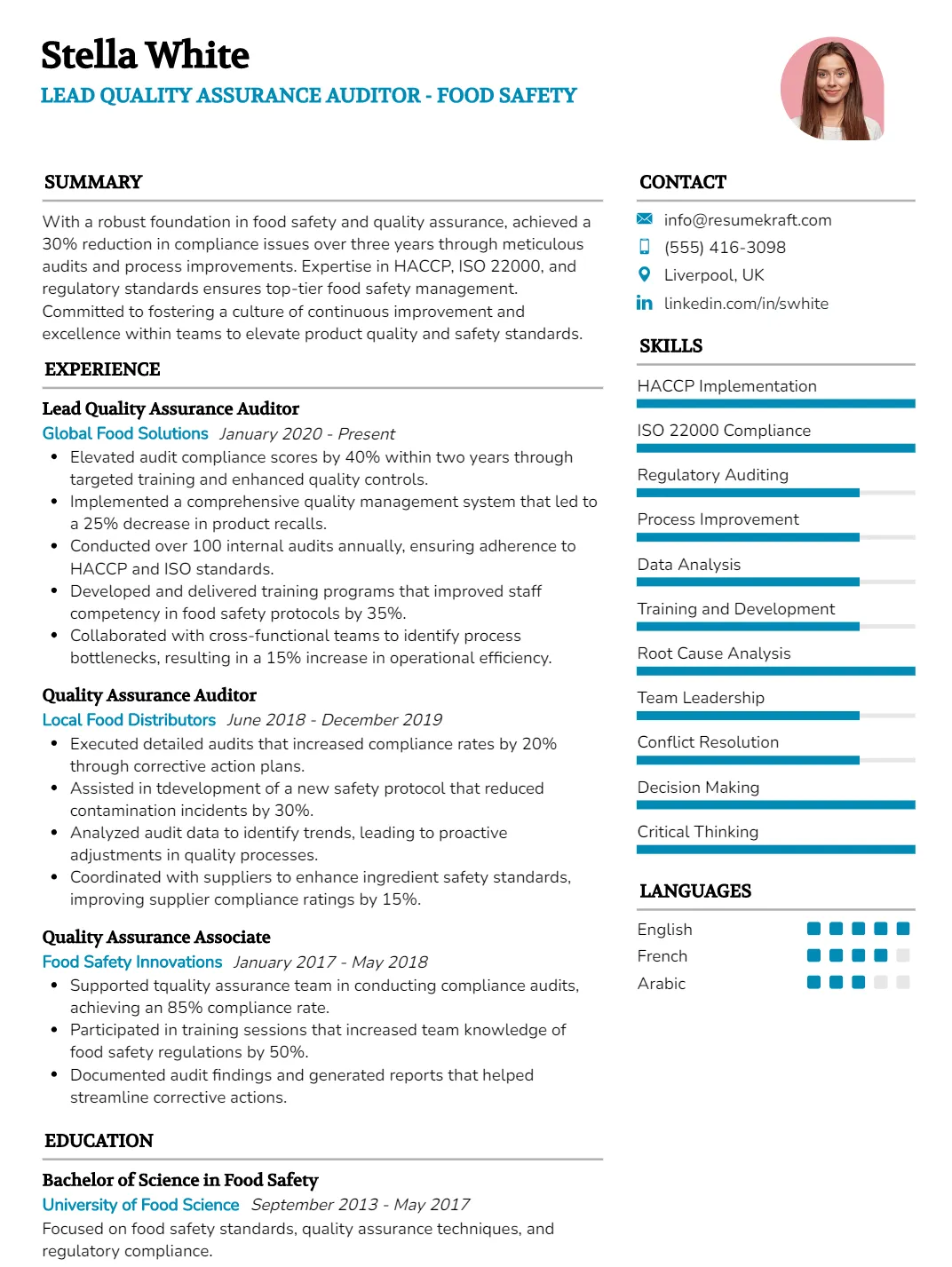
Why This Resume Works
This resume effectively highlights relevant skills such as HACCP implementation and ISO 22000 compliance, aligning perfectly with the Lead Quality Assurance Auditor – Food Safety position. Its clear structure emphasizes seven years of progressive experience in quality assurance roles, showcasing a solid career trajectory. ATS compatibility is ensured through the use of industry-specific keywords, enhancing discoverability. Additionally, strategic presentation of achievements in regulatory auditing and process improvement demonstrates tangible contributions to food safety standards, making this candidate stand out in a competitive field.
Quality Assurance Manager – Aerospace Industry Resume
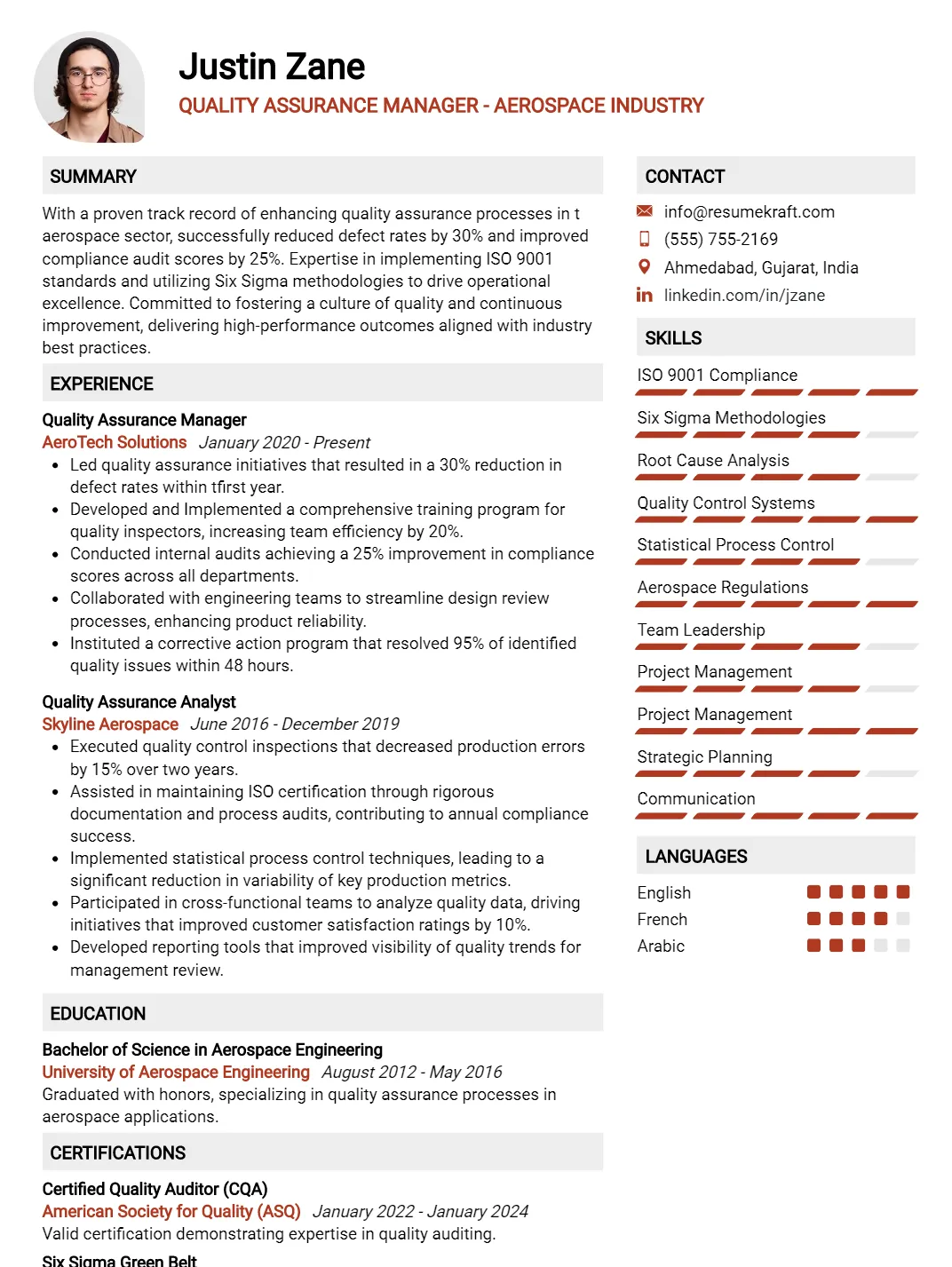
Why This Resume Works
This resume effectively positions the candidate for a Quality Assurance Manager role in the aerospace industry by highlighting essential skills like ISO 9001 compliance and Six Sigma methodologies, which are critical for ensuring quality in aerospace manufacturing. The structured format emphasizes relevant experience, showcasing eight years of progressive responsibility. Additionally, it is optimized for ATS compatibility through the inclusion of industry-specific keywords.
Quality Assurance Coordinator – Pharmaceutical Industry Resume

Why This Resume Works
This resume effectively positions the candidate for a Quality Assurance Coordinator role in the pharmaceutical industry by showcasing 11 years of relevant experience and key skills such as Regulatory Compliance and Root Cause Analysis. Its clear format highlights achievements that demonstrate proficiency in Quality Control Protocols and Risk Management, essential for ensuring product safety. The strategic use of industry-specific keywords enhances ATS compatibility, making it more likely to pass automated screenings, while the structured layout ensures easy readability for hiring managers.
Junior Quality Assurance Analyst – Automotive Industry Resume
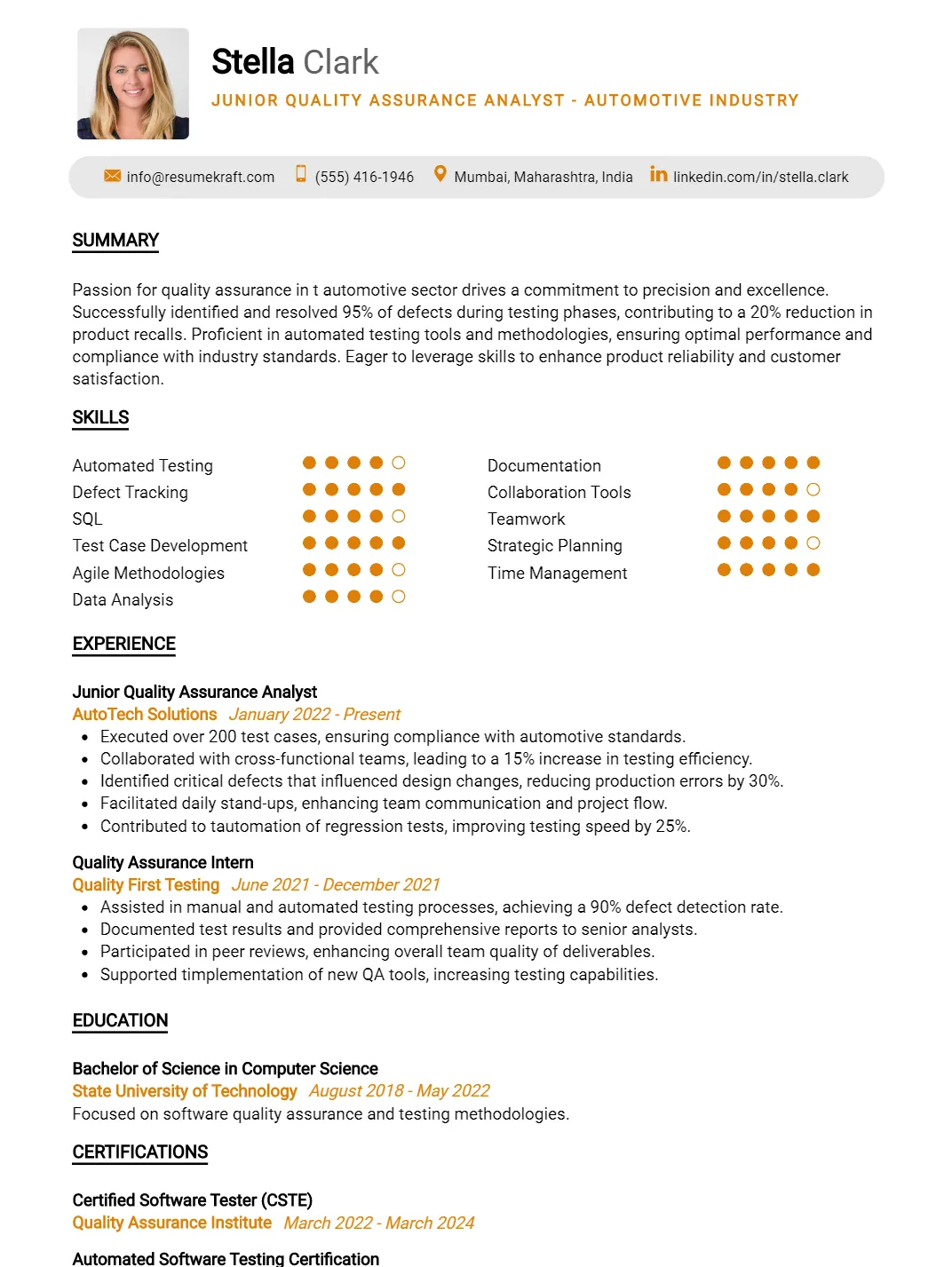
Why This Resume Works
This resume effectively highlights the candidate’s relevant skills, such as Automated Testing and SQL, which are crucial for a Junior Quality Assurance Analyst in the automotive industry. With approximately three years of experience in quality assurance roles, it demonstrates practical knowledge and familiarity with Agile methodologies. The clear format and structured layout enhance readability, while the use of industry-specific keywords ensures ATS compatibility.
Senior Quality Assurance Lead – Telecommunications Resume
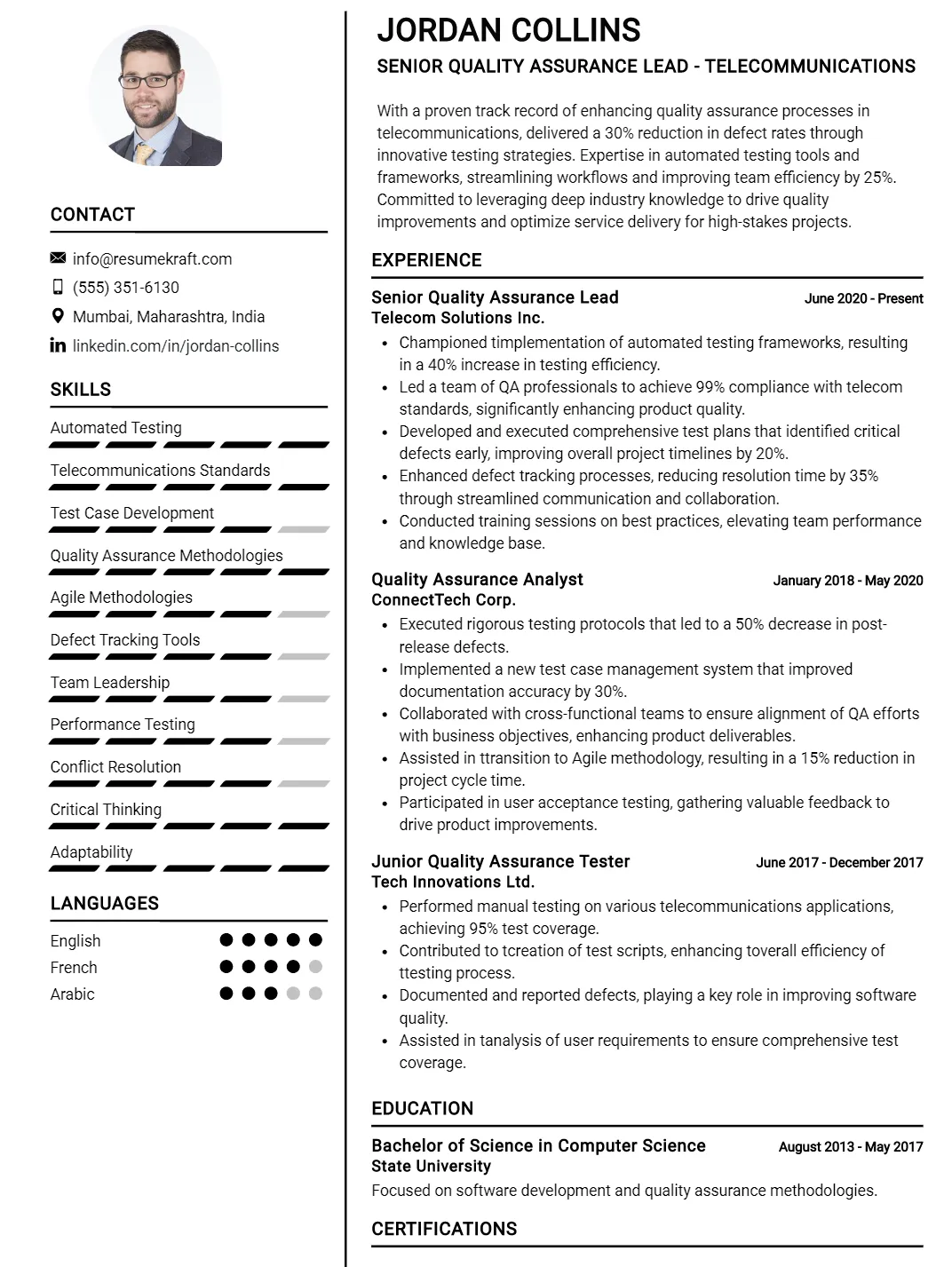
Why This Resume Works
This resume effectively targets the Senior Quality Assurance Lead – Telecommunications position by highlighting key skills such as Automated Testing, Telecommunications Standards, and Agile Methodologies, which are crucial for the role. The structured format ensures easy navigation, showcasing a clear career progression from Junior Tester to Senior Lead. It incorporates relevant keywords for ATS compatibility, enhancing visibility in applicant tracking systems. Additionally, strategic presentation of achievements emphasizes successful project outcomes and adherence to industry standards, making it compelling for hiring managers in telecommunications.
Principal Quality Assurance Engineer – Biotechnology Resume
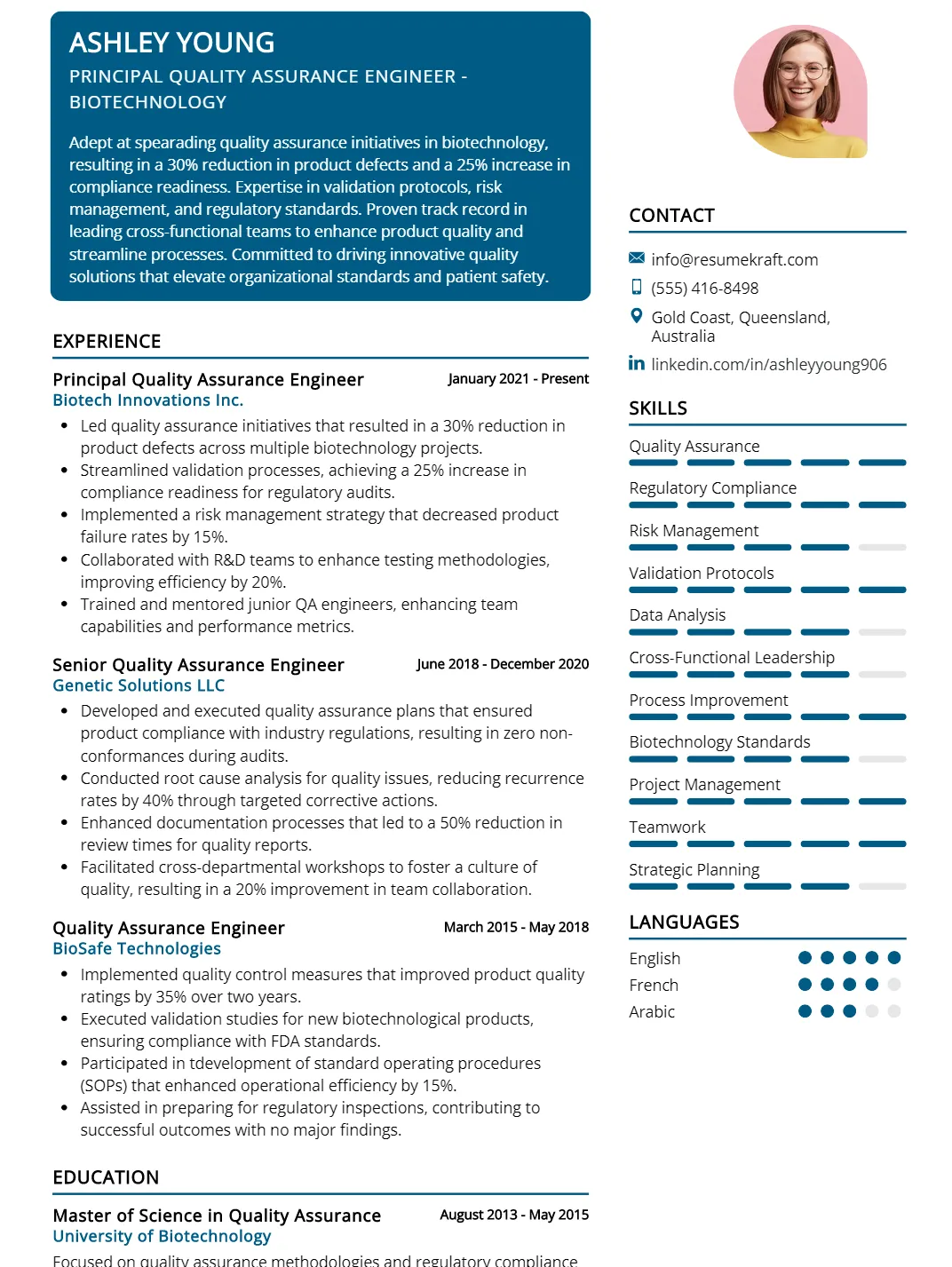
Why This Resume Works
This resume effectively highlights the candidate’s extensive experience in Quality Assurance within the biotechnology sector, showcasing nearly nine years of progressive roles. The emphasis on key skills such as Regulatory Compliance and Validation Protocols aligns perfectly with the requirements for a Principal Quality Assurance Engineer. Its structured format enhances readability, while strategic bullet points ensure ATS compatibility by incorporating industry-relevant keywords. Additionally, quantifiable achievements are presented to demonstrate tangible contributions to quality improvements, making this resume particularly compelling for hiring managers in biotechnology.
Quality Assurance Program Director – Healthcare Technology Resume
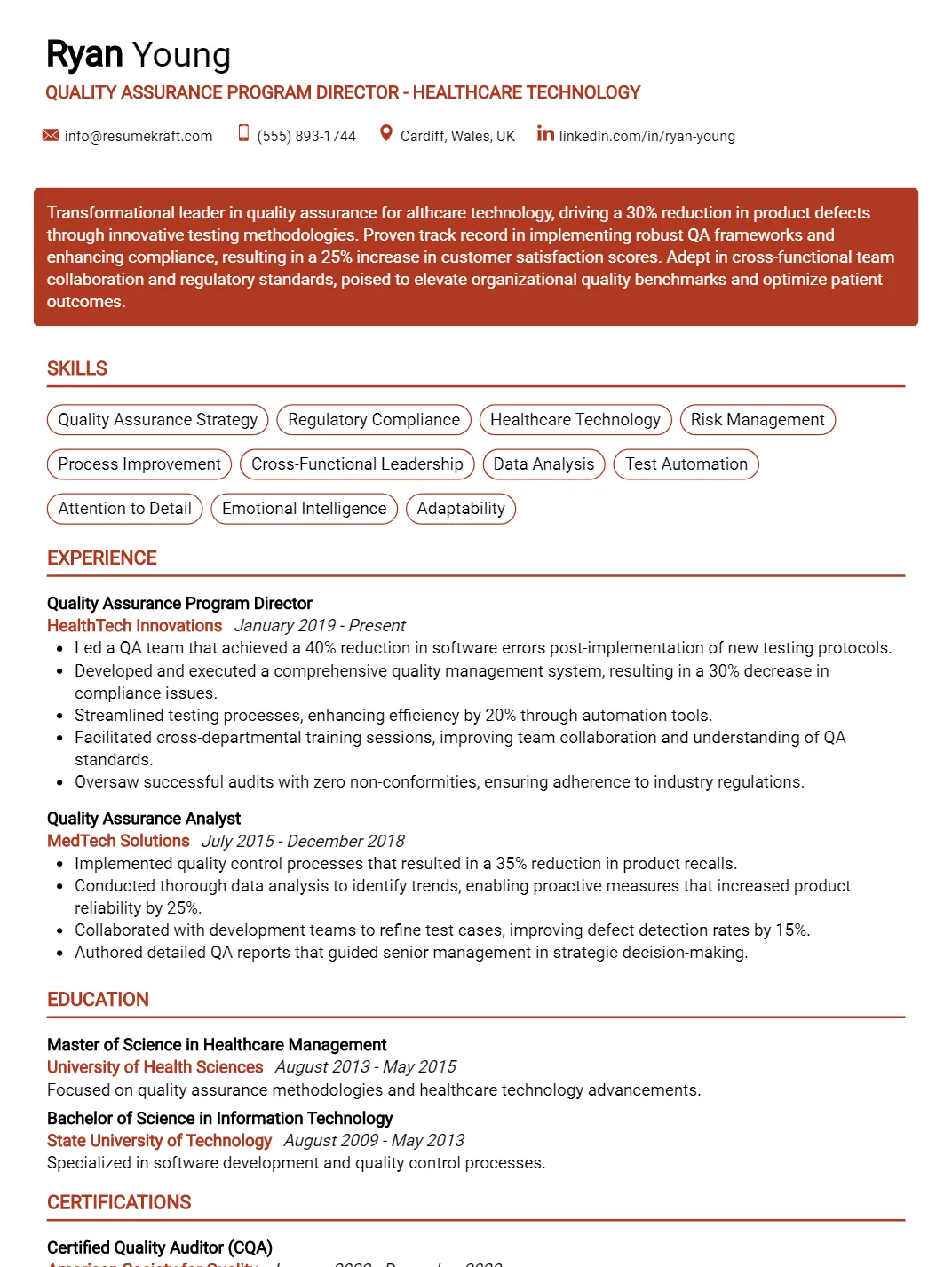
Why This Resume Works
This resume effectively highlights the candidate’s extensive experience as a Quality Assurance Program Director and Analyst, showcasing nearly nine years in healthcare technology. The emphasis on key skills like regulatory compliance and risk management aligns perfectly with industry standards. Its clear structure enhances readability, making it ATS-compatible by incorporating relevant keywords. Additionally, strategic presentation of achievements demonstrates measurable impacts on quality assurance processes, reinforcing the candidate’s capability to lead and improve healthcare technology initiatives, making them an ideal fit for the role.
Quality Assurance Director – Renewable Energy Industry Resume
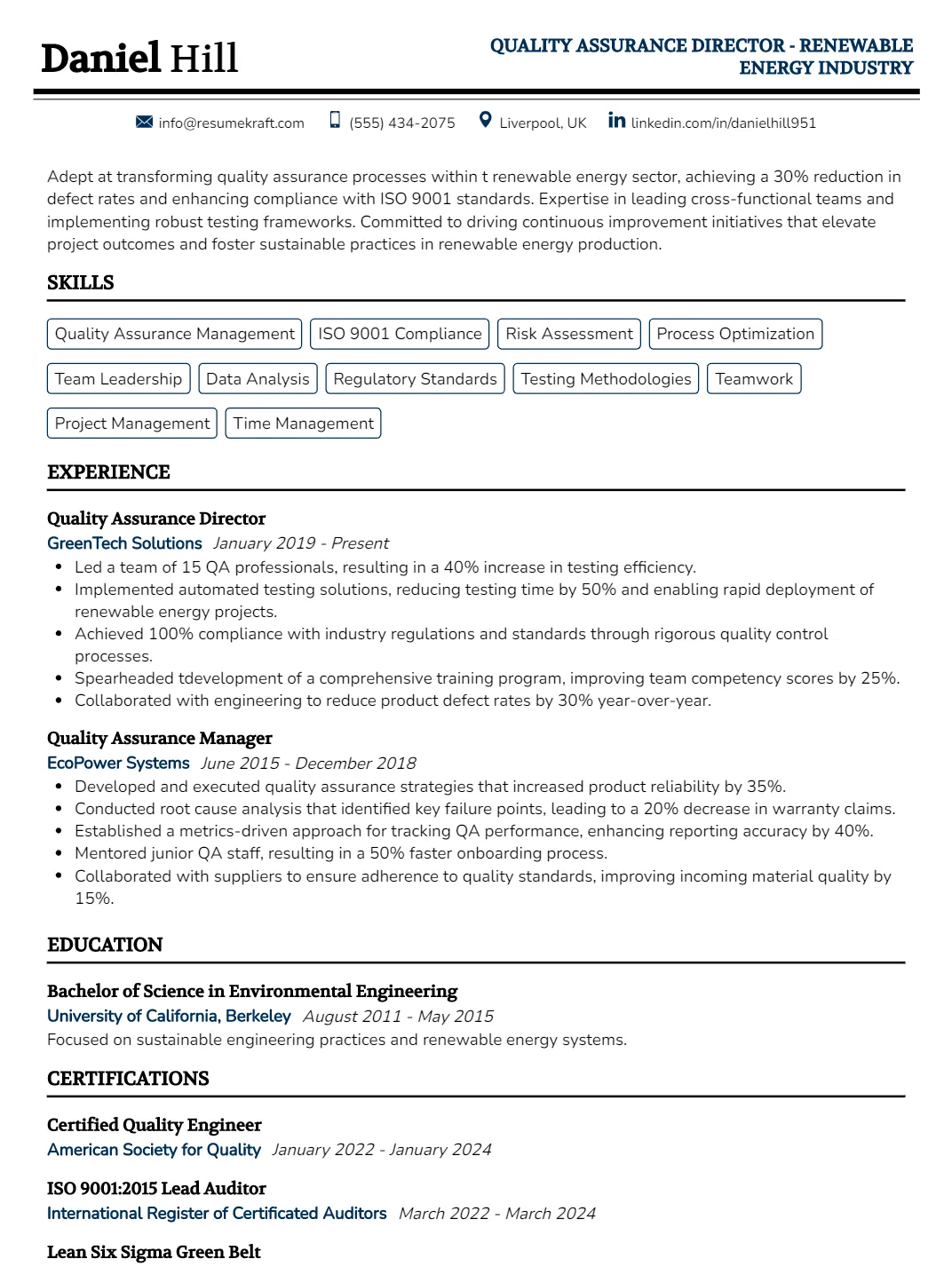
Why This Resume Works
This resume effectively highlights the candidate’s extensive experience as a Quality Assurance Director and Manager, showcasing nearly nine years of relevant expertise in the renewable energy sector. The inclusion of key skills like ISO 9001 Compliance and Risk Assessment aligns with industry standards, enhancing its appeal. The structured format facilitates easy navigation, while strategic presentation of achievements emphasizes process optimization and team leadership—crucial for this role. Additionally, the use of industry-specific keywords ensures ATS compatibility, further increasing visibility to potential employers.
Quality Assurance Compliance Specialist – Manufacturing Resume
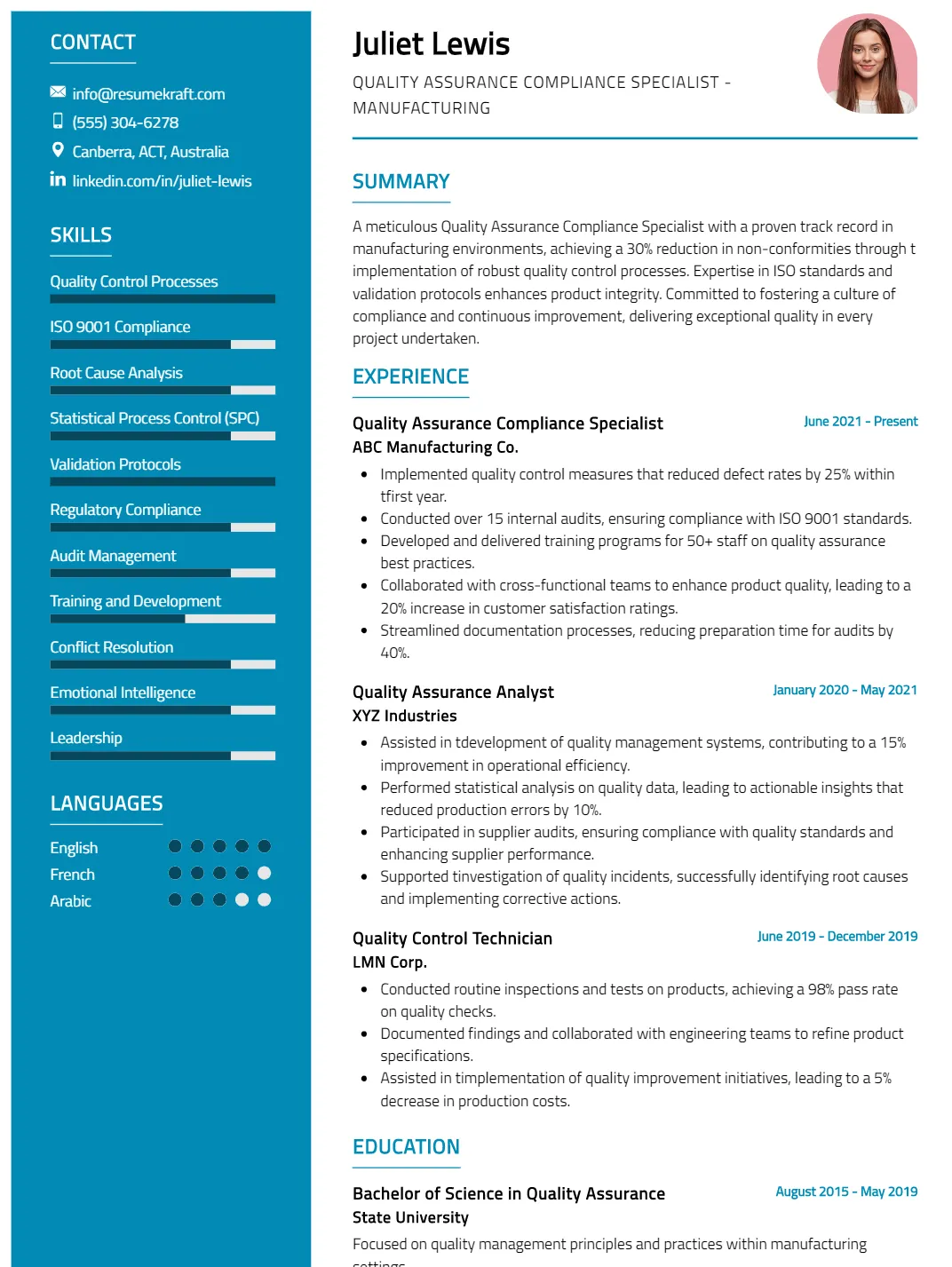
Why This Resume Works
This resume effectively highlights the candidate’s relevant skills and experience for a Quality Assurance Compliance Specialist – Manufacturing position by emphasizing expertise in ISO 9001 compliance and statistical process control. Its clear, structured format ensures easy navigation, showcasing key achievements that demonstrate success in quality control processes. Additionally, the use of industry-specific keywords enhances ATS compatibility, increasing visibility to hiring managers. Overall, this targeted presentation aligns perfectly with the demands of the role, making it a strong contender for the position.
Quality Assurance Automation Engineer – Consumer Electronics Resume
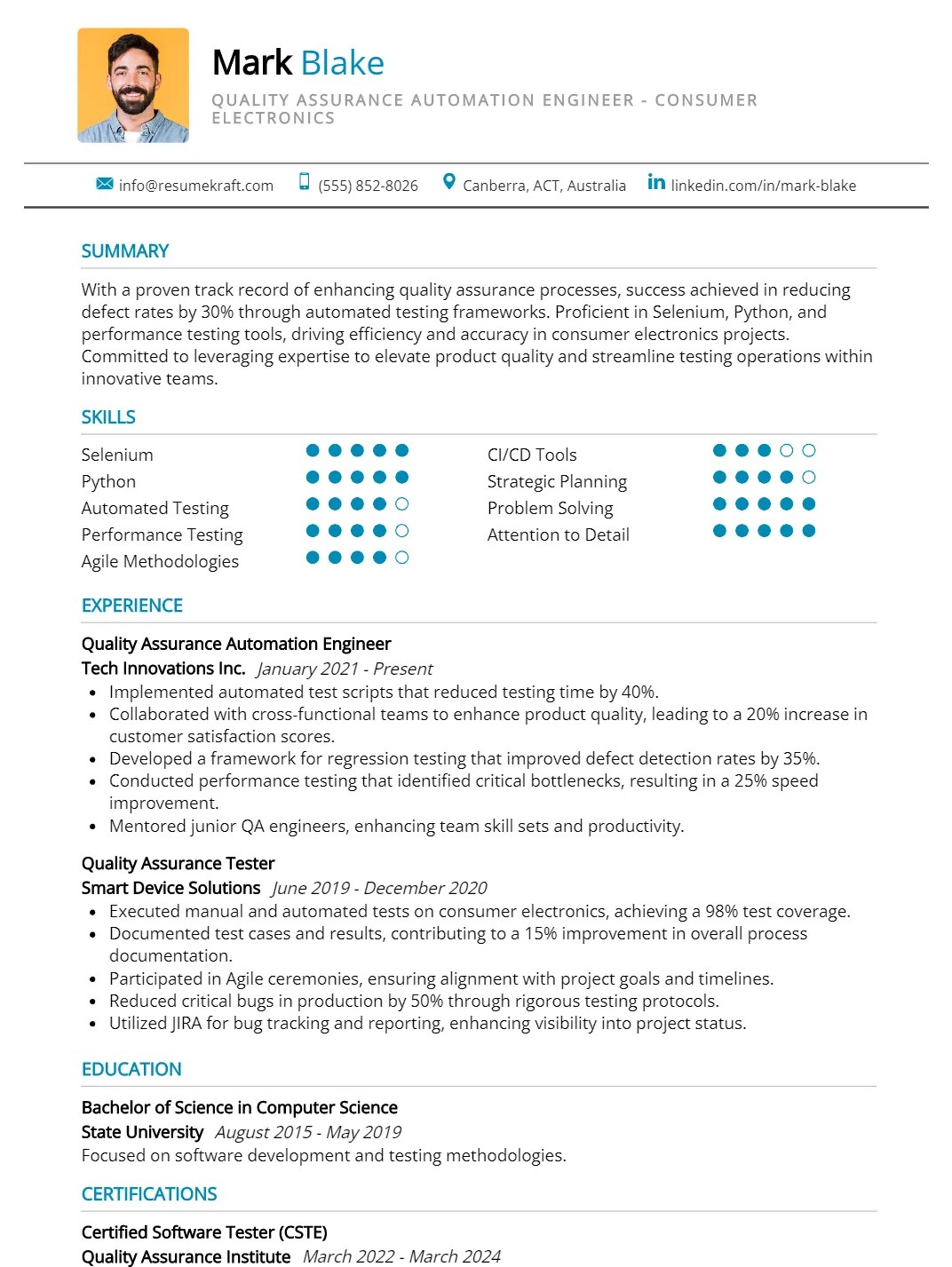
Why This Resume Works
This resume effectively showcases the candidate’s relevant skills, such as Selenium and Python, directly aligning with the requirements of a Quality Assurance Automation Engineer in Consumer Electronics. The structured format highlights approximately five years of experience in quality assurance roles, making their expertise immediately apparent. Its clear organization enhances ATS compatibility by incorporating industry-specific keywords. Additionally, strategic presentation of achievements related to automated and performance testing demonstrates a proven track record, making this resume compelling for potential employers in the consumer electronics sector.
Quality Assurance Risk Manager – Financial Services Resume
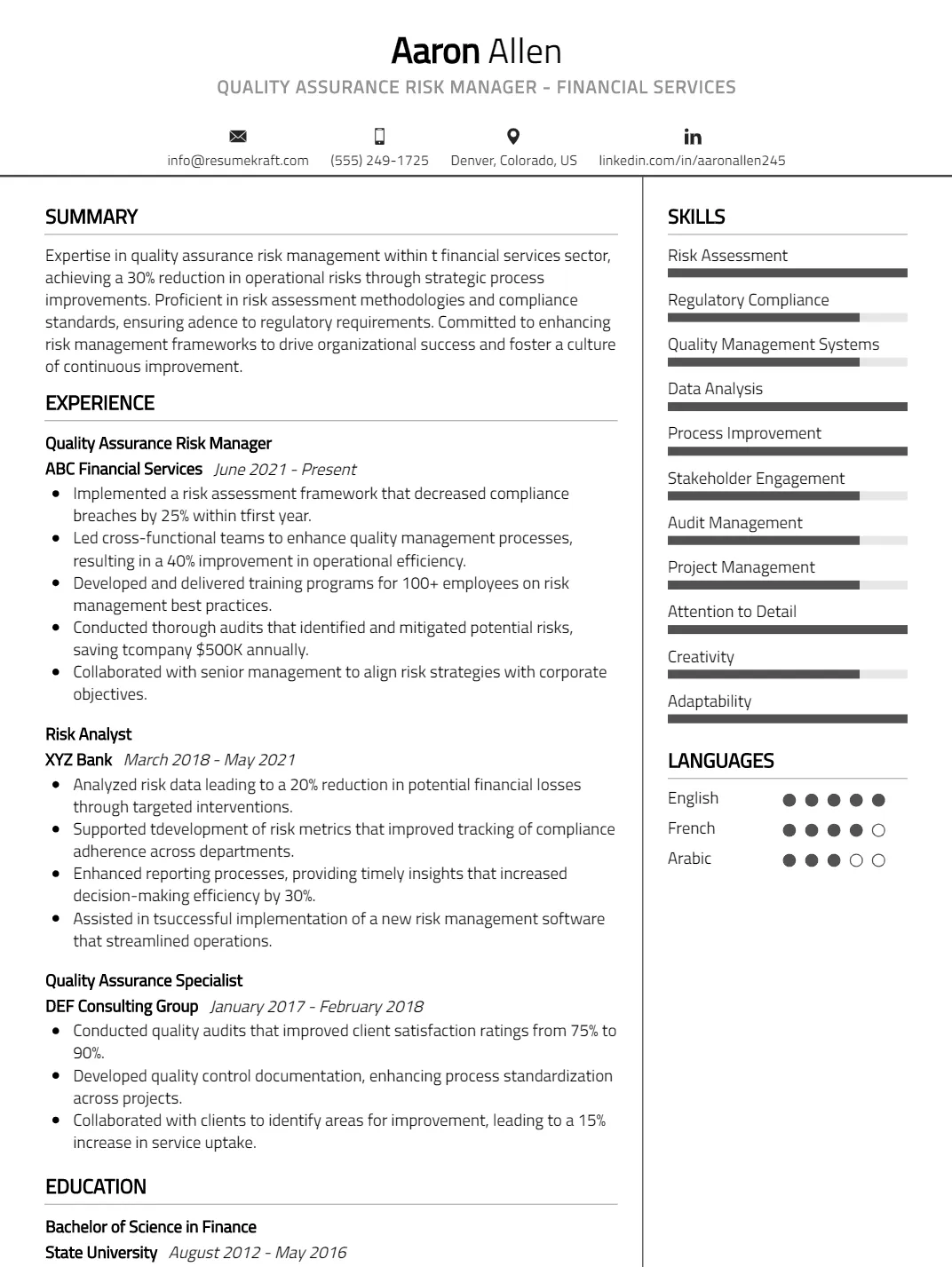
Why This Resume Works
This resume effectively highlights the candidate’s eight years of relevant experience in quality assurance and risk management, showcasing key skills such as Risk Assessment and Regulatory Compliance, which are crucial for a Quality Assurance Risk Manager in financial services. The structured format emphasizes achievements that demonstrate proficiency in Quality Management Systems and Process Improvement. Additionally, strategic keyword usage enhances ATS compatibility, ensuring visibility to hiring managers. Overall, the tailored presentation of skills and accomplishments aligns perfectly with industry expectations and job requirements.
How to format a Quality Assurance resume
Proper formatting is crucial for a Quality Assurance resume, as it enhances readability and ensures that your skills and experiences stand out. A well-organized resume format can make a significant difference in capturing the attention of hiring managers.
- Use clear section headings like “Experience,” “Skills,” and “Education” to guide hiring managers through your qualifications, making it easy for them to locate pertinent information quickly.
- Prioritize relevant QA experiences and skills at the top of your resume, ensuring they are the first things a recruiter sees, showcasing your qualifications for the role immediately.
- Utilize bullet points for listing responsibilities and achievements in your work experience; this improves readability and allows hiring managers to scan your accomplishments efficiently.
- Maintain consistent font styles and sizes throughout your resume to create a polished look. Choose professional fonts like Arial or Calibri and keep sizes between 10-12 points for clarity.
- Incorporate white space strategically to avoid clutter; this enhances overall readability and ensures that each section of your resume is distinct and easy to navigate for the reader.
How to write your Quality Assurance resume experience
Effectively presenting work experience on a Quality Assurance resume is vital, as it showcases your ability to ensure product quality and reliability. Employers seek candidates who can demonstrate a solid understanding of testing methodologies, attention to detail, and the capability to identify and resolve issues promptly. A well-crafted experience section can significantly enhance your chances of standing out in a competitive job market.
A strong work experience section highlights specific achievements and quantifiable results, allowing prospective employers to gauge your expertise. Focus on using action verbs and concrete examples of your contributions to previous projects, as this will illustrate your impact on the overall quality and performance of products.
Worked in Quality Assurance. Did some testing and reported bugs.
Executed automated and manual tests for a software application, identifying 30 critical bugs that improved user satisfaction by 25% and reduced post-release defects by 40%.
How to list your hard skills and soft skills on your resume
In the field of Quality Assurance (QA), showcasing both hard and soft skills on your resume is crucial for demonstrating your comprehensive abilities. Hard skills, such as familiarity with testing tools and methodologies, provide a clear indication of your technical competencies and ability to perform specific tasks. Conversely, soft skills, like communication and problem-solving, highlight your capacity to collaborate effectively with teams and adapt to challenges. Together, these skill sets create a well-rounded candidate capable of ensuring product quality and enhancing team dynamics.
Hard Skills:
- Test Automation: Proficient in using automation tools like Selenium and QTP for efficient testing.
- Manual Testing: Experienced in executing manual test cases to ensure software functionality.
- Defect Tracking: Skilled in using JIRA and Bugzilla to track and manage defects.
- API Testing: Knowledgeable in testing APIs using Postman and SoapUI.
- Performance Testing: Experienced with tools like LoadRunner and JMeter to assess application performance.
- Regression Testing: Ability to conduct regression tests to validate new code changes.
- Test Case Design: Proficient in designing effective test cases based on requirements.
- SQL: Familiarity with SQL for validating database integrity and query results.
- Agile Methodologies: Understanding of Agile practices and participation in Scrum meetings.
- Version Control: Experience using Git for managing code changes and collaboration.
- Continuous Integration: Knowledge of CI/CD tools like Jenkins for automated testing.
- Test Planning: Ability to create comprehensive test plans based on project scope.
- Risk Assessment: Skilled in identifying and evaluating risks associated with software releases.
- Usability Testing: Experience in assessing user experience and interface usability.
- Compliance Testing: Knowledgeable in ensuring software meets industry standards and regulations.
Soft Skills:
- Attention to Detail: Meticulous in identifying discrepancies and ensuring accuracy.
- Analytical Thinking: Strong problem-solving skills to analyze issues and propose solutions.
- Effective Communication: Ability to convey technical information clearly to non-technical stakeholders.
- Team Collaboration: Works well in teams to achieve common quality objectives.
- Time Management: Efficiently prioritizes tasks to meet tight deadlines.
- Adaptability: Flexible in adjusting to new technologies and methodologies.
- Critical Thinking: Evaluates situations logically to make informed decisions.
- Customer Focus: Committed to understanding client needs and enhancing customer satisfaction.
- Conflict Resolution: Skilled at resolving conflicts and fostering a positive work environment.
- Initiative: Proactively identifies areas for improvement and suggests enhancements.
- Creativity: Thinks outside the box to develop innovative testing strategies.
- Mentoring: Capable of guiding and training junior QA team members.
- Empathy: Understands the perspectives of users to improve product quality.
- Resilience: Maintains focus and determination in challenging testing scenarios.
- Networking: Builds relationships with colleagues and industry professionals to share knowledge.
- Open-mindedness: Willing to consider new ideas and approaches in quality assurance.
How to list your certifications and education on your resume
When presenting certifications and education on a Quality Assurance resume, it’s crucial to highlight qualifications that directly relate to the QA field. Include any degrees in Computer Science, Engineering, or related disciplines, as well as certifications like ISTQB, CSTE, or Six Sigma. Clearly list the institution, degree, and graduation year in reverse chronological order to emphasize your most recent achievements.
Additionally, ensure that your certifications are prominently displayed, ideally in a separate section. Use bullet points for clarity and include the certification name, issuing organization, and date obtained. This structured approach helps to quickly convey your qualifications and shows commitment to professional development in Quality Assurance.
Graduated from various schools and took some QA courses. Certifications include a few random ones.
Bachelor of Science in Computer Science, XYZ University, 2022. Certified Software Tester (CSTE), Quality Assurance Institute, 2023.
How to write your Quality Assurance resume summary or objective
A strong resume summary or objective is crucial for a Quality Assurance position as it provides a snapshot of your skills and career goals to potential employers. A summary highlights your relevant experience, achievements, and qualifications, making it ideal for those with some background in QA. Conversely, an objective statement is beneficial for entry-level candidates or those transitioning from another field, focusing on what you aim to contribute to the company.
Seeking a position in Quality Assurance. I have some experience and I’m eager to learn more about testing processes and software.
Detail-oriented QA specialist with 5 years of experience in automated testing and a proven track record of identifying issues early, improving product quality by 30%, and reducing release times by 20%.
Additional sections for a Quality Assurance resume
Including additional sections in your Quality Assurance resume can significantly enhance its impact, showcasing your comprehensive skill set and relevant experiences. These sections can provide deeper insights into your qualifications, setting you apart from other candidates in a competitive job market.
- Certifications: Highlighting relevant certifications, such as ISTQB or CSTE, demonstrates your commitment to the field and showcases your expertise in quality assurance methodologies and tools.
- Projects: Detailing specific projects you have worked on allows potential employers to see your practical experience and how you have successfully applied QA principles in real-world scenarios.
- Technical Skills: Listing your technical skills, including programming languages and testing tools, provides clarity on your technical capabilities and helps recruiters quickly assess your fit for the position.
- Professional Affiliations: Membership in relevant industry organizations shows your engagement with the QA community and commitment to staying updated on industry trends and best practices.
- Awards and Recognition: Mentioning any awards or recognitions received for your work in quality assurance can validate your expertise and highlight your contributions to previous employers, making you a standout candidate.
Key takeaways for writing a professional Quality Assurance resume
- Highlight relevant certifications such as ISTQB to showcase your expertise and commitment to quality assurance practices in your resume.
- Use specific metrics in your accomplishments, such as “reduced defect rates by 30%,” to demonstrate the impact of your work effectively.
- Tailor your resume to the job description, emphasizing skills and experiences that align with the specific requirements of the Quality Assurance role.
- Consider utilizing resume templates designed for Quality Assurance professionals to ensure a professional layout and structure that captures attention.
- Leverage an ai resume builder to streamline the writing process, ensuring your resume is polished and aligned with industry standards quickly.
Frequently Asked Questions
How long should my Quality Assurance resume be?
Your Quality Assurance resume should ideally be one page, particularly if you have less than 10 years of experience. This length allows you to effectively present your skills, experiences, and accomplishments without overwhelming the reader. If you have extensive experience or a diverse skill set, you may extend it to two pages. However, ensure that every section is relevant and contributes to showcasing your qualifications in the QA field.
What is the best format for a Quality Assurance resume?
The best format for a Quality Assurance resume is the reverse-chronological format. This structure highlights your most recent experiences and achievements first, making it easy for hiring managers to see your career progression. Use clear headings and bullet points to organize information, ensuring that key skills, certifications, and relevant work experience are easily identifiable. Additionally, consider using a clean, professional design that enhances readability and draws attention to your qualifications.
What should I highlight on my Quality Assurance resume to stand out?
To stand out on your Quality Assurance resume, emphasize your technical skills, such as proficiency with testing tools (like Selenium or JIRA) and programming languages (like SQL or Python). Highlight your experience with different testing methodologies (manual, automated, performance) and any relevant certifications (like ISTQB). Additionally, showcase your problem-solving abilities, attention to detail, and collaboration skills, as these are crucial in QA roles. Tailor your achievements to align with the specific requirements of the job you are applying for.
What are some ways to quantify my experience on my Quality Assurance resume?
Quantifying your experience on a Quality Assurance resume can significantly enhance its impact. Use metrics such as the number of test cases executed, defects identified and resolved, or percentage of test coverage achieved. For instance, you could state that you improved test coverage by 30% or reduced defect leakage to production by 20%. Additionally, mention any cost savings or time reductions achieved through your QA processes, as these demonstrate your contributions to project success and efficiency.

